
27 Effective Cross Selling Examples Businesses Should Consider
 Updated on
Updated on
 By Carlos Correa
By Carlos Correa
Carlos Correa
Carlos has been involved in the sales space for well over ten years. He began in the insurance space as an individual sales agent, managing teams as s...
learn more
Carlos Correa
Carlos has been involved in the sales space for well over ten years. He began in the insurance space as an individual sales agent, managing teams as s...
Table of Contents
Table of Contents
One of the most effective ways to maximize the revenue you get from each customer is cross-selling.
Cross-selling can be applied at the point of sale or after the initial purchase and works for service businesses, software companies, and those who sell physical products like retail businesses and e-commerce stores.
So yeah, it's a pretty versatile tactic to have under your belt as a sales rep.
In this article, we're going to explore exactly what cross-selling is.
We'll discuss the difference between cross-selling and upselling (a related but slightly different sales tactic), before diving into the top cross-selling strategies to implement in your own sales process.
We're also going to discuss a few examples of cross-selling, and feature several cross-selling email examples, so you'll walk away knowing exactly how to nail the elusive cross-sell.
What is Cross-Selling?
Cross-selling is the marketing of additional products and services that supplement what the customer is already buying. Basically, the idea of cross-selling is to go "Hey, you bought that thing, you might like to buy this thing as well!" The most well-known example is when Amazon (the king of cross-selling) recommends complementary products to customers, like this:

The recommendation might be based on sales history (that is, other customers frequently buy the items together), or on logic (these things work together, so there's a possibility that you'll like this thing as well).
In any event, the idea is pretty similar to selling in general: you're recommending products or services based on identified customer needs.
That means you're not just throwing product recommendations at the wall and seeing what sticks. You've got to understand customer needs, pain points, and motivations, as well as how the product or service you're looking to cross-sell complements the thing they already have.
Its cousin, upselling, is also a popular approach.
Upselling and Cross-Selling Examples: What's the Difference?
This guide is about cross-selling, not upselling. Our main goal here is to answer the question, "What is an example of cross-selling?"
Before we get into those examples, though, let's quickly elaborate on the difference between upselling and cross-selling so we're all clear.
While cross-selling focuses on recommending complementary products to customers, upselling focuses on selling better products.
Let's say you're a car salesperson at Mercedes. Your customer wants to buy an E 350 sedan. An upsell would involve trying to get them into an E 450 4MATIC, for instance.
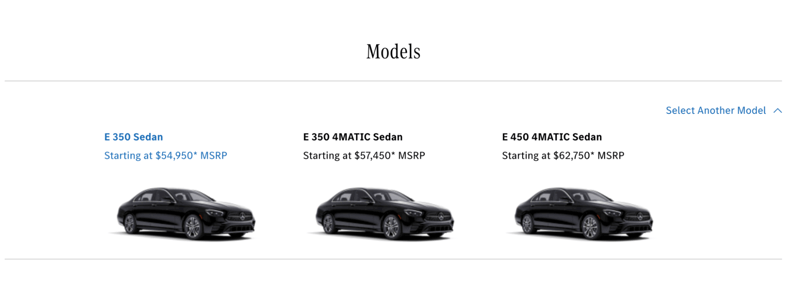
The idea here is that the product isn't complementary; you're not trying to sell both the E 350 and the E 450.
Cross-selling would be recommending products that work well with what they're already buying (the E 350). In this case, we're talking about warranties, servicing, and upgrade packages to the vehicle itself.
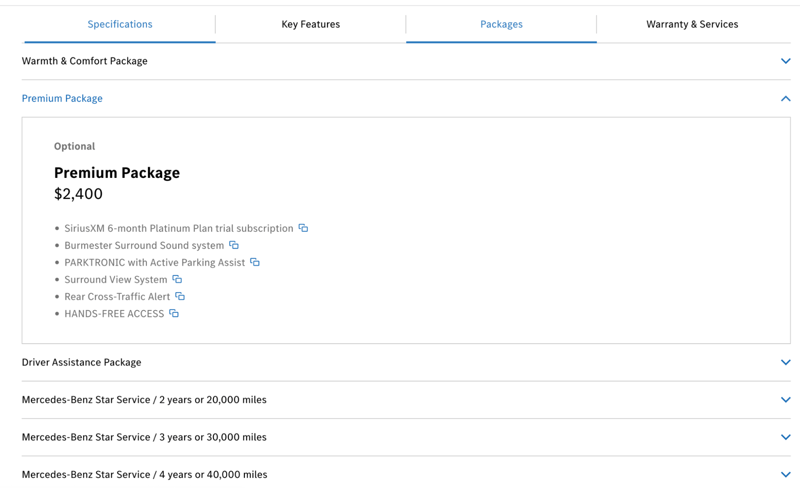
As you're probably realizing, cross-selling and upselling can actually be used in conjunction. For instance, you could upsell the customer into an E 450 and still cross-sell the Driver Assistance Package.
Both upselling and cross-selling can be used in the context of SaaS and subscription sales, too.
Let's say you're an Account Executive at a marketing automation platform. You used a tiered pricing model, with three different packages available:
- Starter
- Business
- Professional
Each successive plan includes a deeper feature set and higher limits for things like API requests and monthly email sends.
Customers also have the option to purchase a number of add-on products, such as:
- Additional API requests
- Additional monthly email sends
- SMS marketing capabilities
- Landing page builder
- Enterprise grade customer support
You're speaking with a customer who is about to sign up for the Business plan.
In this scenario, an upsell would involve convincing the customer to upgrade to the Professional plan. Cross-selling, on the other hand, would occur if you sold any of those additional products, regardless of whether the customer upgrades to the Professional plan or not.
As such, upselling and cross-selling can occur simultaneously, and both are tactics that every good sales rep should have under their belts.
To summarize:
|
Sales tactic |
Definition |
|
Cross-selling |
Recommending additional products that complement what the customer is already purchasing. |
|
Upselling |
Recommending better products that upgrade what the customer is purchasing. |
Training and Empowering Sales Teams in Cross-Selling
Equipping your sales team with the knowledge and tools to effectively cross-sell is crucial for maximizing the success of your strategy. Here's how to train and empower your team:
Educating Sales Teams on Cross-Selling Techniques and Best Practices
Sales representatives should have a thorough understanding of cross-selling concepts and best practices. This includes:
- Product knowledge: In-depth knowledge of your product offerings and how they complement each other allows for informed recommendations.
- Identifying customer needs: Train your team to actively listen and uncover customer pain points and aspirations. This helps them tailor cross-selling suggestions to address specific needs.
- Building value propositions: Teach your team to craft compelling value propositions that highlight the benefits of complementary products or services.
- Overcoming objections: Equip your team with strategies to address customer concerns and objections related to cross-selling effectively.
Providing Ongoing Training and Support
Sales techniques and customer behavior can evolve over time, so ongoing training and support are essential. Update your team regularly on new cross-selling strategies, industry trends, and best practices. Consider role-playing exercises to practice communication and objection-handling skills.
Empowering Sales Teams with the Tools and Resources Needed for Success
Give your sales team the resources they need to excel at cross-selling. This could include:
- Product information and sales collateral: Provide clear and concise product information that highlights key features and benefits.
- Customer data and analytics: Equip your team with customer data and insights to personalize cross-selling recommendations.
- Cross-selling software and tools: Utilize technology solutions that recommend relevant products based on customer profiles and purchase history.
By investing in training, ongoing support, and the right tools, your sales team will be empowered to confidently and effectively implement your cross-selling strategy, ultimately driving sales and customer satisfaction.
Why Include Cross-Selling As One Of Your Sales Strategies?

The biggest reason to include cross-selling as a sales strategy? More revenue per customer.
Pretty straightforward, sure, but let's look at some numbers (that's what sales is all about, right?)
Let's say you're a sales rep for a software company. Your typical customer signs up for the $30 per month plan and has 40 users.
Your average annual customer value is $30 x 40 users x 12 months = $14,400.
Let's say you get really good at cross-selling an add-on package your company has recently released. It goes for just $5 extra per user, and you can cross-sell the product to one in every four customers successfully.
That's an extra $600 per customer yearly ($5 per user x 40 users per average deal x 12 months / 4 customers).
At scale (let's say, 1,000 customers), the difference becomes obvious:
|
Without cross-selling |
With cross-selling |
|
|
Average annual revenue per customer |
$14,400 |
$15,000 |
|
Total annual revenue |
$14.4m |
$15m |
|
Revenue driven by cross-selling |
$0 |
$600,0000 |
A cool $600k a year just from recommending an additional product.
Top 7 Cross-Selling Strategies
Okay, so how does this whole thing work?
Let's look at seven strategies for cross-selling to illustrate.
- The supplemental cross-sell
- The "people also buy" cross-sell
- The "complete the look" cross-sell
- The partner cross-sell
- The personalized cross-sell
- The influencer cross-sell
- The bundle cross-sell
1. The supplemental cross-sell
The supplemental cross-sell is the archetypal example of cross-selling.
When the customer is poised to purchase one product, you recommend another product that works well with it.
Take this example from Coccinelle.
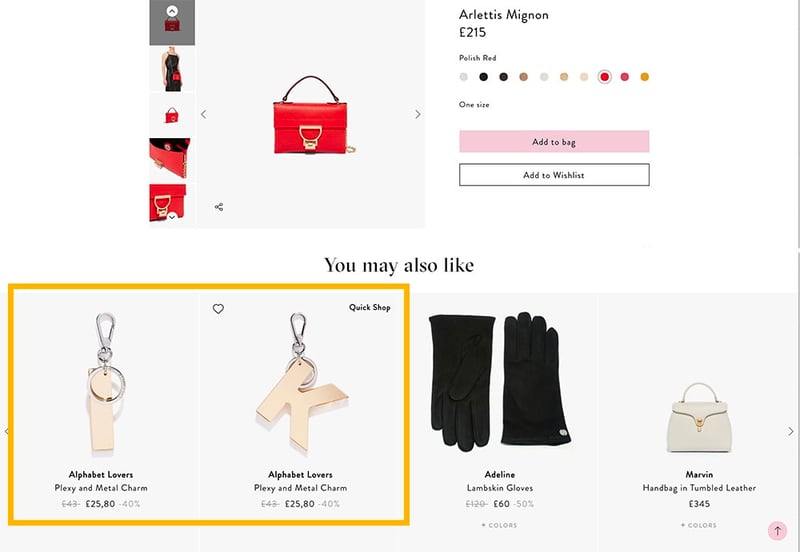
The customer is considering purchasing an Arlettis Mignon handbag, and Coccinelle jumps in with a cross-sell recommendation of metal letter charms.
The strategy here is simple: these two products work together, so someone who buys the handbag is likely to also want the keychain.
2. The "people also buy" cross-sell
You'll see the "people also buy" all over the internet on e-commerce websites.
Amazon basically came up with this strategy back when they only sold books (remember that?)
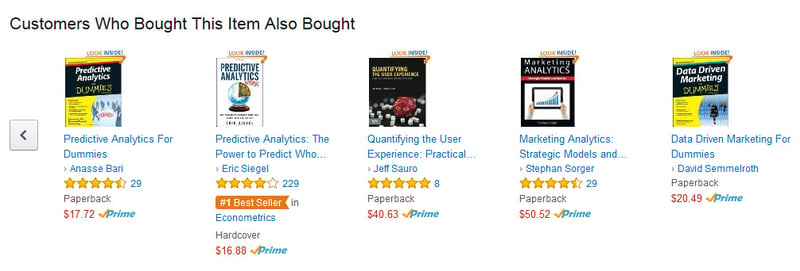
The strategy here is based on data rather than on assumptions about products that go together.
In the case of the above cross-selling example, customers who bought one book on predictive analytics bought other books on the topic, as well as on data-driven marketing.
So, because others buy these books together, the assumption is that the current customer might wish to also.
3. The "complete the look" cross-sell
The "complete the look" cross-sell strategy is often used in the retail clothing industry.
The idea behind this cross-selling strategy is pretty simple: certain clothing items go with others to create outfits.
If someone is buying one item, they might be interested in purchasing another one.
Take this example from Madewell:
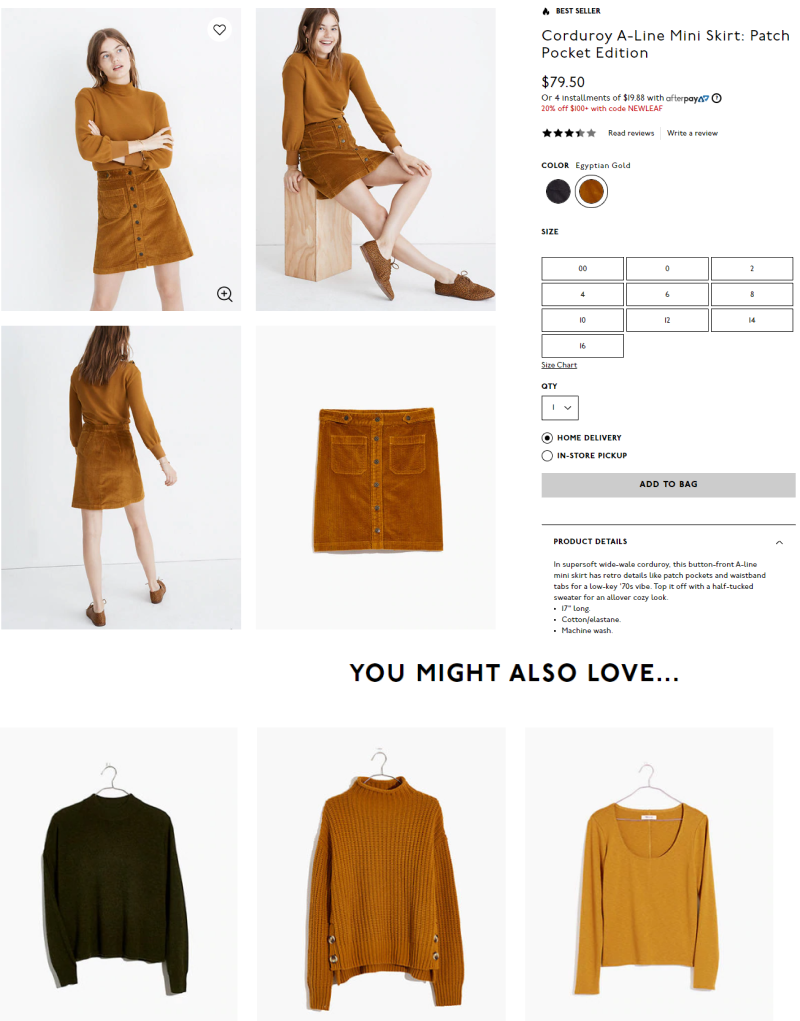
In this example, the customer is looking at a skirt, so Madewell recommends three tops to go with it.
What makes this a successful example of cross-selling is the fact that the images used to feature the skirt also include a top similar to those recommended, so customers can visualize what the two items look like when worn together.
4. The partner cross-sell
The partner cross-sell is a style of cross-selling where you recommend an additional product that you don't actually sell, but a partner company does.
Take this example of cross-selling from Apple.
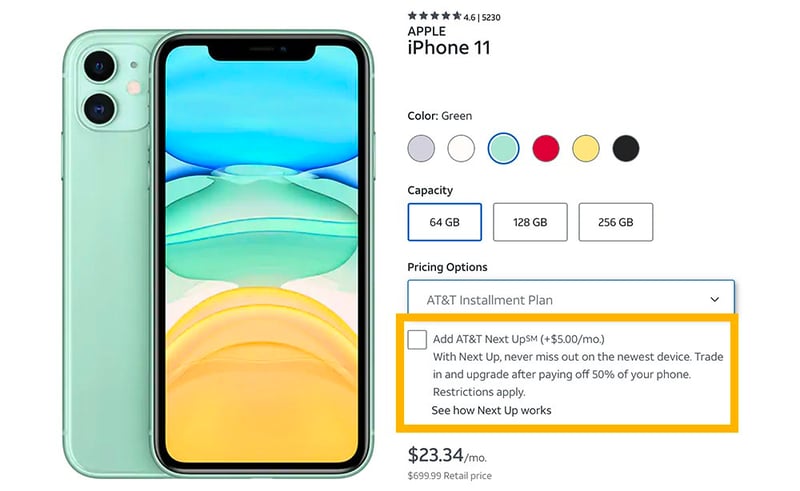
The customer is looking at buying an iPhone 11, and Apple recommends an add-on from their pattern AT&T.
The assumption here is that Apple gets some kind of kickback from AT&T, making the cross-sell effort worthwhile on their part.
5. The personalized cross-sell
A personalized cross-selling strategy can be used when you have some decent data on a customer's previous purchases.
Let's say you're a makeup supplier.
One of your customers is looking at buying a new lipstick from your site, and you know that five months ago, they bought a blush that's expected to last for around six months.
So, you jump in with a cross-selling attempt recommending the blush that they're probably due for a refill on, like this:
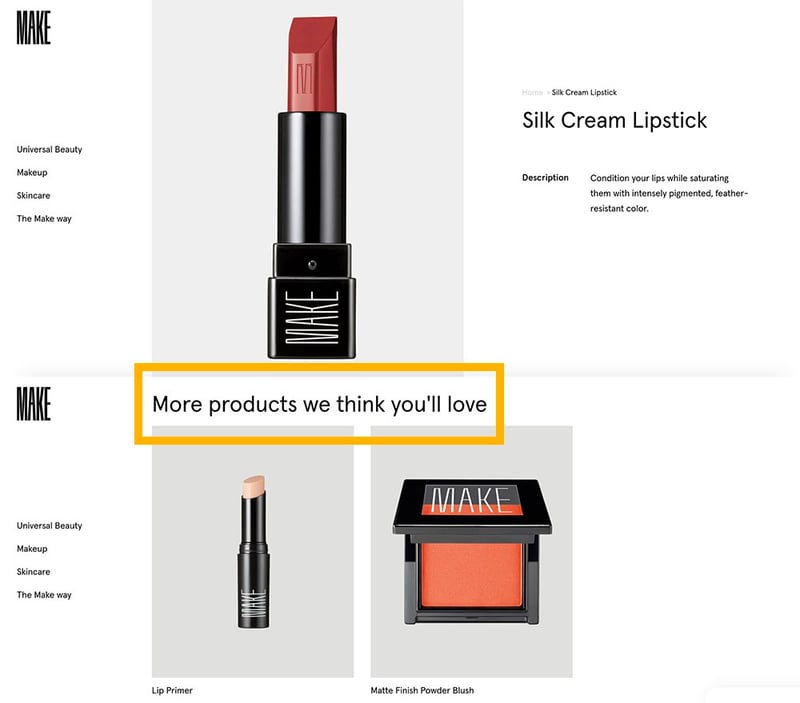
6. The influencer cross-sell
The influencer cross-selling strategy incorporates the leverage of an influencer into any other cross-selling example.
For example, rather than including a "people also buy" section, you might run a "[influencer name] also wears" recommendation and then include an image of the influencer wearing both items, like this:
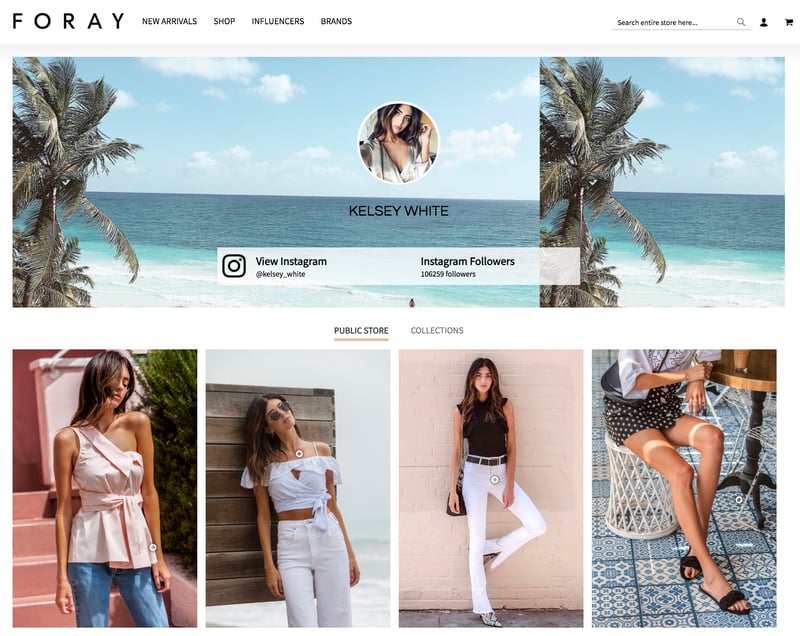
7. The bundle cross-sell
The bundle cross-selling strategy is when you recommend multiple items at once.
McDonalds is a classic example of a company that uses this cross-selling strategy. Customers want a burger, but you sell them a combo with fries and a drink.
This cross-selling strategy can be used in e-commerce as well. Amazon (again) shows us how to do this correctly:

Examples of When to Cross-Sell
Here's how you can identify the ideal moments to cross-sell to your customers.
Know Your Customers
Successful cross-selling hinges on understanding your customers' needs and preferences. By gathering customer data and insights, you can tailor the cross-selling examples and strategies discussed below to different customer segments. This personalized approach increases the relevance of your recommendations and the likelihood of a positive response.
Customer data can be utilized by analyzing purchase history, browsing behavior, and feedback. These insights can reveal patterns and trends in customer preferences, allowing you to identify cross-selling opportunities.
Identify Cross-Selling Opportunities
Imagine you sell cameras. Analyzing customer data from your CRM system might reveal that customers who buy DSLR cameras frequently purchase tripods and camera bags. This presents a perfect opportunity to recommend these complementary products during the checkout process or through targeted email campaigns.
Predictive analytics and recommendation engines can further enhance your efforts. These tools analyze vast amounts of customer data to suggest relevant products based on past purchases and broader buying trends.
Building Trust and Adding Value
Ultimately, the key to successful cross-selling is building trust and adding value to the customer experience. Don't just push additional products; instead, recommend items that genuinely complement the initial purchase and address the customer's specific needs.
Personalized recommendations and expert advice go a long way in establishing trust and making customers feel valued.
15 Examples of Cross-Selling
We know you've still got the burning question:
"What is an example of cross-selling?"
To answer, let's look at a few different cross-selling examples that you might be able to apply in your own sales efforts.
Cross-selling Examples in High-Ticket B2B Sales
- A marketing agency's primary service offering is SEO (search engine optimization) services. A salesperson at the agency cross-sells content creation services as an additional complementary product.
- An accountancy firm primarily services enterprise customers by creating quarterly financial reports like cash flow statements and balance sheets. A cross-sell attempt is made to offer financial advice based on the statements provided.
- An office supplies company contacts each of its enterprise-level accounts to let them know about a new product line—electric standing desks—and makes a cross-sell attempt where appropriate.
Cross-selling Examples in Retail Sales
- A customer is purchasing a pair of new leather shoes, and the salesperson recommends some leather care items to accompany the purchase.
- A customer buys a new above-ground pool, and the sales rep cross-sells a pool cover to keep debris out of the water.
- A sales rep at a used car dealership recommends a variety of insurance products to supplement a customer's vehicle purchase.
Cross-selling Examples in SaaS Sales
- A sales representative selling a CRM platform recommends the purchase of their email marketing add-on.
- A customer is about to buy a project management platform, and the sales agent cross-sells a setup and integration service to get the platform plugged into the other software the client is already using.
- A video editing platform recommends the purchase of their photo editing tool at a discounted price when new customers create an account.
Cross-selling Examples in Customer Success
- A customer success rep at an email marketing software company recognizes that one of their customers is getting most of their leads through social media and makes a cross-sell recommendation for their social media marketing automation add-on.
- An e-commerce platform cross-sells its chatbot tool to customers who've already built a website and are attracting more than 10,000 customers a month.
- An account manager at a cloud computing company cross-sells its data security consulting services to high-value accounts.
Cross-selling examples in e-commerce
- A customer adds a pair of track pants to their cart, and the e-commerce site recommends the matching tracksuit top.
- A customer is about to check out and purchase several pairs of underpants, and the e-commerce site recommends some socks that might also be of interest.
- A customer is about to purchase a new laptop online, and the site makes a bundle cross-sell recommendation, offering a keyboard, mouse, case, and cybersecurity software package at a discounted rate.
5 Examples of Cross-Selling Emails

Interested in designing some cross-selling emails?
Check out these five cross-selling email examples as inspiration.
1. Price Drop Alert Cross-Sell
UNIQLO combines two different email marketing techniques with this cross-selling email example:
- Price drop alert
- Cross-sell recommendations
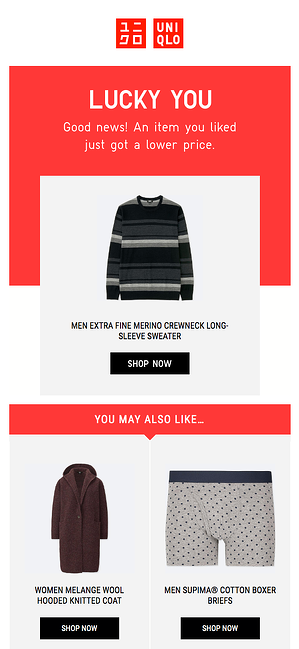
In the above email, a customer has previously been browsing a merino crewneck but didn't go through with the purchase.
Now that the item is on sale, UNIQLO sends an automated email letting the customer know it has a discount, which might just be the motivator they need to purchase.
To double down on the offer, they include a couple of cross-selling attempts, hoping that at least one of the three advertisements will garner a click-through and get the customer on their site.
2. Post-Purchase Cross-Sell
Sambag uses cross-selling emails to influence repeat purchases.

In the above cross-selling email example, the customer has already purchased an item from Sambag.
The assumption is that they've already received it (since this email references a recent purchase but doesn't include a "get it in the same delivery" message), so the idea is to make a cross-sell recommendation of some items that would accompany their new purchase to influence a repeat purchase.
3. Maximum value cross-sell
In this cross-selling email example from Dollar Shave Club, we see an example of how e-commerce companies use cross-selling to recommend products that are literally made to go together.

In this example, the customer has just purchased some travel-sized shaving items, so DSC jumps in with a cross-sell recommendation of their travel bag.
Notice how this is a contextual cross-sell; it wouldn't make sense to recommend a travel bag to someone who has just purchased a bunch of full-size items.
Dollar Shave Club also rounds out the cross-selling email with a couple of additional travel-sized items, making the most of that screen real estate.
4. Common Combo Cross-Sell
In this cross-selling email example, it's clear that the customer has just purchased a pair of shoes, despite not being covered in the email itself.

That's because these cross-sell product recommendations are highly-contextual; nothing goes with a pair of new shoes like some comfy socks and colorful laces to spice things up and customize your look.
5. Abandoned shopping cart cross-sell
Like UNIQLO, Indigo attacks with the old-one two in this cross-selling email example, combining their cross-sell attempt with an abandoned shopping cart follow-up reminder.

Here, the customer has previously added two items to their cart:
- A mug
- A book
In following up with an automated abandoned cart recovery email, Indigo recommends some similar products, running with the logic that perhaps what the customer was browsing previously wasn't quite what they were after, and that if they recommend something similar, they can seal the deal.
Cross-Selling Email Templates

Not sure how to get started writing your first cross-selling email?
Steal inspiration from these templates.
"Add to Your Shipment" Cross-Selling Email Template
Hey [name],
[product] is about to ship.
Why not add a little something extra for no extra shipping cost!?
[cross-sell product] [cross-sell product] [cross-sell product]
"Abandoned Cart" Cross-Selling Email Template
Hi [name],
You left something behind!
[abandoned cart product]
Not quite what you're looking for? Check out these similar items, you might just find something you love.
[cross-sell product] [cross-sell product] [cross-sell product]
"Price Drop Alert" Cross-Selling Email Template
[name]!
[product name] has must had a price drop!
[product image]
Get in while it's hot. At this price, they won't be around for long!
While you're at it, we think you might like one or two of these products:
[cross-sell product] [cross-sell product] [cross-sell product]
Frequently Asked Questions
What is Cross-Selling and Up-Selling with Examples?
Cross-selling is the process of recommending additional products or services that complement what the customer is already buying. Upselling is the process of recommending a better product or service. For instance, if a customer is purchasing a CRM platform, and selling them, an email automation add-on is cross-selling, and getting them into a higher pricing tier is upselling.
What Are Cross-Sell Products?
Cross-sell products are any products that you recommend a customer buy to supplement the purchase they're already making. For example, if the customer is buying a pair of jeans from your e-commerce store, you might make cross-sell recommendations for a shirt, a belt, and a pair of shoes that go with the jeans they're already buying.
What is Cross-Selling on Amazon?
Cross-selling is the process of recommending additional products that complement a buyer's existing purchase.
On Amazon, this largely takes place in the "Frequently bought together" and "Customer show bought this item also bought" sections, like this:
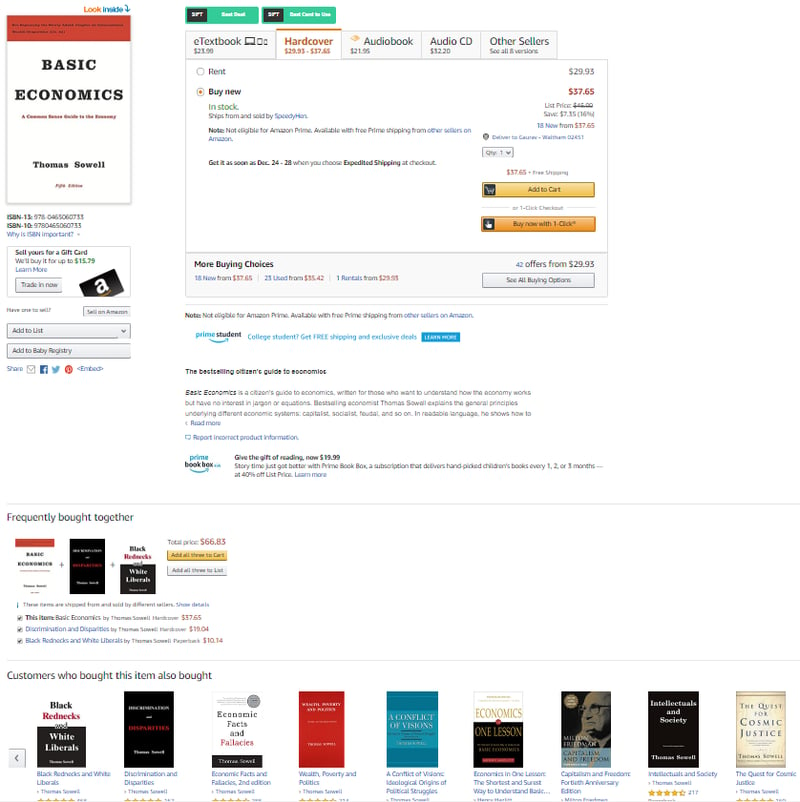
Is Cross-Selling Ethical?
Yes! Remember, your goal in sales, whether cross-selling or otherwise, is to provide a helpful solution to your customer.
Cross-selling a product or service you know they don't need probably isn't all that ethical, but if you're confident that your solution can help, make that money, baby!
Conclusion
Cross-selling can happen in a number of different ways.
It can happen at the point of sale, such as when a retail sales rep recommends additional clothing items or when Amazon recommends products that are frequently bought together.
In the B2B world, cross-selling is often most effective when the attempt comes after a customer has already made their initial purchase. This is often referred to as the "land and expand" model.
To nail this approach, you'll need some good insights into customer behavior, and a powerful reporting and analytics suite from your CRM.
Check out Ringy today, and then book a demo with the team to find out exactly how we can help guide your cross-selling activities.

Skyrocket your sales with the CRM that does it all.
Calling? Check. SMS? Check. Automation and AI? Check. Effortlessly keep in touch with your customers and boost your revenue without limits.

Take your sales to new heights with Ringy.
Sales in a slump? Ringy gives you the tools and flexibility you need to capture leads, engage with them, and turn them into customers.
Subscribe to Our Blog
Enter your email to get the latest updates sent straight to your inbox!
Categories
Related Articles



































































































